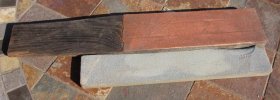BluntCut MetalWorks
Knifemaker / Craftsman / Service Provider
- Joined
- Apr 28, 2012
- Messages
- 3,464
It took 20 minutes to set new bevel and then sharpened 2 knives to 220 w/d sandpaper + stropped(balanced-strop) to newsprint slicing sharpness. Sorry, camera battery died around 8 min 25 secs  grumpy: didn't noticed). So it only captured the new bevel setting for knife1. Good/long/bore enough, I guess
grumpy: didn't noticed). So it only captured the new bevel setting for knife1. Good/long/bore enough, I guess 
Knife 1: 14C28N steel, subzero ht, ~61rc
Knife 2: 1084 ht ~59rc
Belt: Norton Blaze 2x42 120grit ceramic
Recently, it took me less than 3 minutes to set new bevel for a new D2 knife with similar profile. K390 blade took twice as long; however it was a bigger knife.
Thanks for watching...
[video=youtube_share;uI4e5LDqlDo]http://youtu.be/uI4e5LDqlDo[/video]
Knife 1: 14C28N steel, subzero ht, ~61rc
Knife 2: 1084 ht ~59rc
Belt: Norton Blaze 2x42 120grit ceramic
Recently, it took me less than 3 minutes to set new bevel for a new D2 knife with similar profile. K390 blade took twice as long; however it was a bigger knife.
Thanks for watching...
[video=youtube_share;uI4e5LDqlDo]http://youtu.be/uI4e5LDqlDo[/video]




